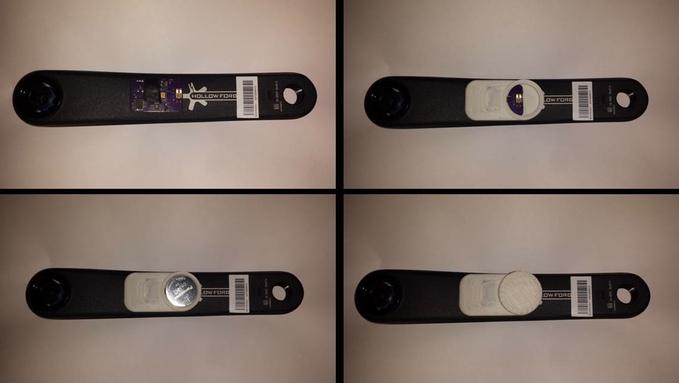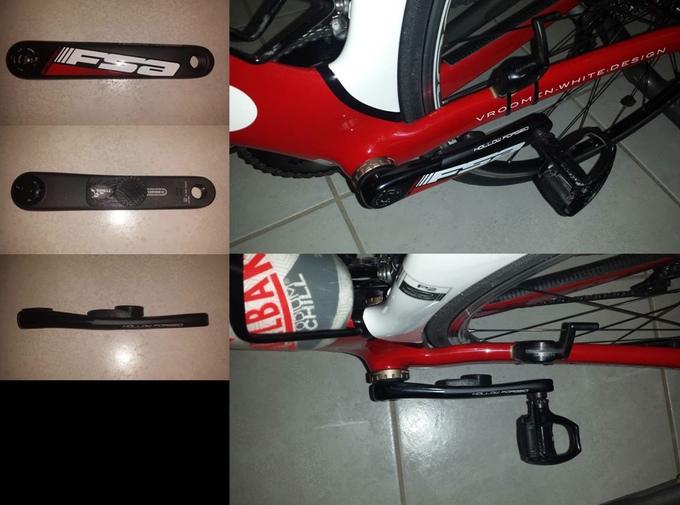- News
- Reviews
- Bikes
- Components
- Bar tape & grips
- Bottom brackets
- Brake & gear cables
- Brake & STI levers
- Brake pads & spares
- Brakes
- Cassettes & freewheels
- Chains
- Chainsets & chainrings
- Derailleurs - front
- Derailleurs - rear
- Forks
- Gear levers & shifters
- Groupsets
- Handlebars & extensions
- Headsets
- Hubs
- Inner tubes
- Pedals
- Quick releases & skewers
- Saddles
- Seatposts
- Stems
- Wheels
- Tyres
- Tubeless valves
- Accessories
- Accessories - misc
- Computer mounts
- Bags
- Bar ends
- Bike bags & cases
- Bottle cages
- Bottles
- Cameras
- Car racks
- Child seats
- Computers
- Glasses
- GPS units
- Helmets
- Lights - front
- Lights - rear
- Lights - sets
- Locks
- Mirrors
- Mudguards
- Racks
- Pumps & CO2 inflators
- Puncture kits
- Reflectives
- Smart watches
- Stands and racks
- Trailers
- Clothing
- Health, fitness and nutrition
- Tools and workshop
- Miscellaneous
- Buyers Guides
- Features
- Forum
- Recommends
- Podcast
TECH NEWS
 tempo shot.png
tempo shot.pngAt $295, is the Tempo the most affordable power meter yet?
There has been a huge proliferation of power meters in the past couple of years, and with the increasing choice has come a bit more affordability. Looking like the most affordable yet is the new Tempo, which has hit Kickstarter this week with a price of just $295.
The Tempo is a crank arm power meter, very much like the popular Stages power meter used by Team Sky. The sensor is mounted to the left crank arm and uses ANT+ to send data to a compatible head unit. The company is able to offer the low price of $295 because you supply the crank arm, and Tempo will install the power meter.
- How to choose a cycling power meter — a buyer's guide to your power training options
The Tempo measures 33mm x 60mm and is just 10.5mm thick. The case is injection moulded plastic and will be water and impact resistant - the photos show a 3D printed prototype. It’s claimed to have a 200 hour run time from the easily replaced batteries.
.Currently, it’s compatible with most Shimano cranks, road and mountain, and some FSA models. The sensor is bonded to the crank arm using a high strength adhesive and is currently only compatible with metal cranks. It hopes to develop a carbon fibre compatible version in the future.
The company is confident it has fully tested the prototype and that it is ready for production, it just needs the funding to do a production run. The sensors are calibrated and temperature compensated and you can program the power meter for your riding style.
The downside at the moment is the Tempo is only available in the US. It’s seeking $25,000 funding to put the power meter into production and with 46 days to go, it has raised $1,236 from four backers. So some way to go yet. Providing it hits the target, it’ll go into production for a July delivery.
More info here https://www.kickstarter.com/projects/2129451964/affordable-high-performa...
Whether the Tempo goes into production and becomes available in the UK remains to be seen. Currently, one of the most affordable power meters we’ve written about is the bePRO pedal-based system which gets you power for just £347. Meanwhile, a Stages 105 power meter will set you back about £450 if you shop around.
David worked on the road.cc tech team from 2012-2020. Previously he was editor of Bikemagic.com and before that staff writer at RCUK. He's a seasoned cyclist of all disciplines, from road to mountain biking, touring to cyclo-cross, he only wishes he had time to ride them all. He's mildly competitive, though he'll never admit it, and is a frequent road racer but is too lazy to do really well. He currently resides in the Cotswolds, and you can now find him over on his own YouTube channel David Arthur - Just Ride Bikes.
Latest Comments
- Destroyer666 5 sec ago
Anodizing the aluminium is also for corrosion resistance and therefore enhances the longevity of the rims while this is not really a case for...
- bobbinogs 1 hour 13 min ago
Wheelsmith has always been very good for me. Malcolm was always very opinionated so I got bored with him telling me I should be riding tubeless,...
- Terry Hutt 1 hour 33 min ago
I assume you can carry an e-bike battery on the tube if you leave the bike at home. ...
- chrisonabike 2 hours 34 min ago
I love it - it's a roundabout with a sculpture of a roundabout on its desk!
- cmedred 2 hours 36 min ago
From the position of the cyclist when the video starts and the position of the bike later, it looks highly unlikely that the cyclist went "into the...
- Rendel Harris 2 hours 42 min ago
To rhyme with design. I wondered this myself so looked it up a while ago, according to the founder Micki Kozuschek he and his team had a few...
- Rendel Harris 3 hours 35 min ago
It's not being pedantic at all, careless driving is successfully prosecuted (and I have been in court more than once when a driver has been...
- HLaB 3 hours 59 min ago
It's hopefully an urban myth but I heard it was designed that way on purpose, so the cyclepath captured any flooding and the busway would remain clear
- mdavidford 4 hours 1 min ago
I should imagine eating chopsticks anywhere could be potentially rather perilous.
- Rendel Harris 4 hours 19 min ago
When The Badger stopped for protesters (albeit dockworkers rather than farmers) it was their stress gauges rather than his that would have been...


Add new comment
5 comments
We do offer the unit on mass produced cranks with us supplying the cranks along with the meter. We offered shipping us a crank because we are not able to obtain certain models from certain maufacturers.
As far as firmware upgrades, we do have a tool to update the firmware over the air and have done so on a cosistent basis as our test riders provide feedback. As of now the firmware has been stable, but if any issue is ever uncovered, we will certainly provide an update
Thank you for the comments!
-Tempo Power Meter
I would never buy an item like this from start up. You will never get much support and firmware updates will be a joke.
If you're after a reasonably priced power meter solution that's good enough for us weekend warriors you can do alot worse (for instance backing Limits, sorry couldn't resist) than taking a look at the PowerPod from iBike.
It's an interesting way to solve the problem of how to measure input force without directly measuring torque either from the crank arm, spider, pedals, or hub. The basics behind the solution are quite simple - measure speed, elevation, pressure, wind speed, use an estimate for rolling resistance, do some maths, and you have the force used to make the bike go forward, now multiply by cadence to the mix and voila power.
It does have it's limitations - mainly only useful on a surface where the rolling resistance is constant, i.e. tarmac roads and velodromes - but it stands up well against the majority of more expensive DFPM and is reviewed well by DC Rainmaker.
I backed this on Kickstarter and got my unit just before Christmas (a little bit late but we were kept informed at every stage as to what was happening), and I paid about $300 for the unit, clamps for 2 bikes (basicly K-Edge like Go-Pro jobs), and a second speed/cadence sensor.
I've been riding with this now for a couple of months and there have only been a couple of rides where I suspect the power reading hasn't been right at the start of a ride but the unit sorted itself out pretty quickly. Overall I have enough confidence in the output ride vs. ride to trust the data that it's creating.
http://store.ibikesports.com/powerpod-power-meter/powerpod-power-meter
http://www.dcrainmaker.com/2015/08/first-powerpod-power.html
It just seems to be too many variables for my liking. Not only is your rolling resistance going to vary based on the surface, but also the size/type of tire, tire presure and rider weight (affects tire deflection). You're also going to have to account for varying wind resistance. Even assuming you have factored in resistance for each frame, you will still have variables such as rider position, wheels, and even what is the rider wearing (skin suit or rain cape?). In addition to affecting rolling resistance, rider weight is going to factor into your power numbers as well.
For me, I'd rather pay a little more to get a direct measurement. Strava can give me an estimate of my power based on speed, weight, etc, the powerpod looks like it's doing that, and then using wind for further refinement. Being a bit of a DIY'er, and in the US, I decided to go with the Watteam. At $500 for both drive and non-drive side if it gives consistent readings to itself, even if not as accurate as an SRM or PowerTap, I'm happy.
Good to see prices coming down further. Not sure about the business model of you shipping them a crank to fit it to though - how long do you want to be without a crank on your bike? I can't see how this makes it cheaper than offering a range of cranks. If I were them, I'd offer it on some of the best value mass produced cranks, and offer them as a whole crankset as well as left-only. This way when people are building a bike from scratch they can keep costs down.
If I was targetting the cheaper end of the power meter market, I'd forget trying to make it compatible with carbon cranks.